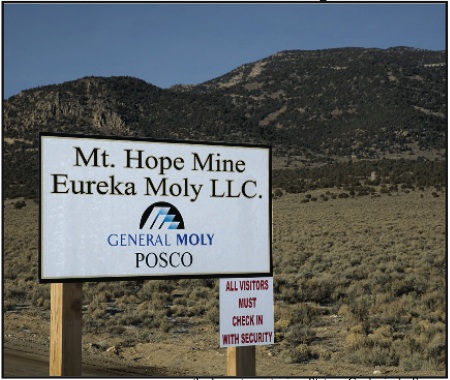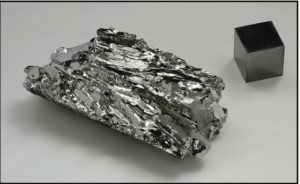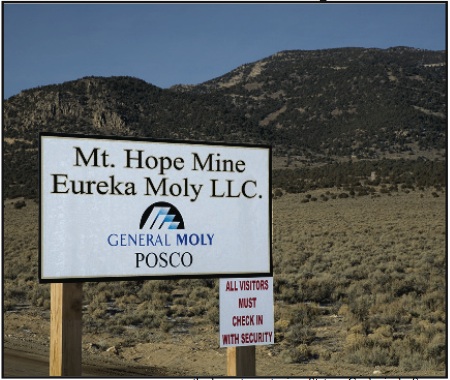
First it was gold, then it was oil, now the next big mineral ‘rush’ is something few people have heard of but nearly every one uses– molybdenum.
A ‘rare earth’ mineral molybdenum or moly was originally used to make steel harder and was the secret ingredient of medieval Japanese samurai sword smiths. Today moly can be found in every computer, smart phone and almost every other new generation gadget and Nevada may have more of the stuff than anywhere else in the world.

Two months ago the Bureau of Land Management gave the green light to the Mt. Hope project. Located just north of Eureka, Nevada Mt. Hope has been described as a mountain of moly and the company behind the project the Chinese Sichuan Hanlong Group plans to blow the top off the mountain and dig it all out.
The enthusiasm for moly could be part of a perceived effort by Communist China to buy up and our develop as many rare earth mines in the world.
Despite their name, rare earth elements are relatively plentiful in the Earth’s crust. However, because of their geochemical properties, rare earth elements are typically dispersed and not often found concentrated as rare earth minerals in economically exploitable ore deposits. It was the very scarcity of these minerals that led to the term “rare earth”.
All of the world’s heavy rare earths come from China such as the polymetallic Bayan Obo deposit. New demand has recently strained supply, and there is growing concern that the world may soon face a shortage of the rare earths. In several years from 2009 worldwide demand for rare earth elements is expected to exceed supply by 40,000 tonnes annually unless major new sources are developed.
[media id=1 width=320 height=240]
As a result of the increased demand and tightening restrictions on exports of the metals from China, some countries are stockpiling rare earth resources and others are looking for new sources. In 2010, the United States Geological Survey (USGS) released a study which found that the United States had 13 million metric tons of rare earth elements.
Chinese business has responded to this potential competition in two ways allege critics. First it dramatically cut the price of the rare earth’s it was producing dramatically causing extreme financial hardship for non-Chinese mines and non-Chinese mining companies and second it has begun buying up and developing sources of rare earths outside of China, such as Eureka’s Mt. Hope and the Liberty project in Tonopah.
 Sichuan Hanlong Group has drawn little notice outside the industry, has dug an estimated $2.2 billion worth of moly out of 10 U.S. mines last year, according to the U.S. Geological Survey and with the Mt. Hope project expected to come on line this year that number should increase dramatically. The project is not however without its detractors including the Eureka County commission.
Sichuan Hanlong Group has drawn little notice outside the industry, has dug an estimated $2.2 billion worth of moly out of 10 U.S. mines last year, according to the U.S. Geological Survey and with the Mt. Hope project expected to come on line this year that number should increase dramatically. The project is not however without its detractors including the Eureka County commission.
In a press release two months ago the Commission noted its objections to the BLM’s decision:
“During the six years of our involvement as a cooperating agency, we advocated design of a project that would protect private property rights and balance all the needs of the County’s resources—socially, environmentally, and economically. We also strongly advocated transparency, public involvement, and adequate resource monitoring, management and mitigation with involvement from stakeholders including Eureka County. The ROD promises that the County will have a minor role in the monitoring of water related impacts only through a yet-to-be-established advisory committee empowered merely to “meet on a periodic basis and make recommendations.” We continue to be concerned that the ROD allows loopholes for the most severe impacts to be attributed to other causes or be “mitigated” through financial compensation to federal and state agencies allowing for off-site mitigation, far removed from where the impact occurs, rather than through effective on-the-ground management. One of our primary fears is that the ROD only calls for mitigation of impacts to surface waters that are considered “perennial.” This continues to be an issue because there are literally dozens of surface waters predicted to be impacted, according to the mine’s own studies, many of which do not meet the strict definition of being perennial but may still be connected to the ground water system that will supply the mine. These surface waters all have associated vested water rights. The ROD allows for EML to adversely impact these important rights and resources.
Also, conspicuously missing from the ROD is discussion about inconsistencies with County plans, policies, and controls. We spent tremendous effort pointing out specific inconsistencies to BLM while highlighting their obligation to include discussion of such in the ROD. Specifically, it is required that “In the Record of Decision, the decision maker [BLM] must explain what the decision was, how it was made, and what mitigation measures are being imposed to lessen adverse environmental impacts of the proposal, among the other requirements . . . This provision would require the decision maker [BLM] to explain any decision to override land use plans, policies or controls for the area” (emphasis added). (Source: Council on Environmental Quality, FAQ 23c). Omission of this information in the ROD underscores our belief that BLM has not properly coordinated with Eureka County on this project by defining a project that minimizes these inconsistencies to the maximum extent possible.”
“They (the developers) have talked a lot,” said Nevada State Senator and former Eureka County Commissioner Pete Goicoechea. “But so far not a lot of work has been done. I think when the new commission convenes this month we should know a whole lot more whether this project gets off the ground.”
If it does a new mineral boom could begin in Nevada perhaps just as big as gold although the cry of ‘Thars moly in them thar hills!!’ might be a little too much to expect.
